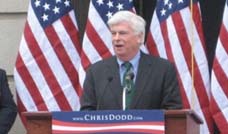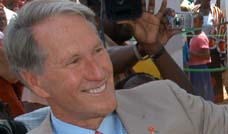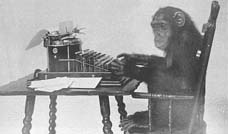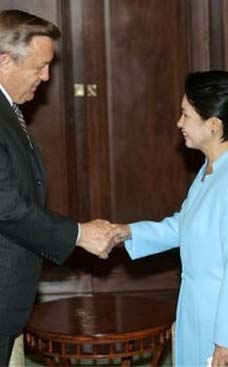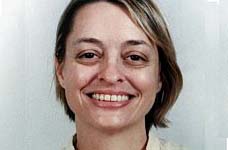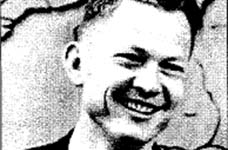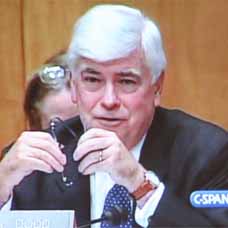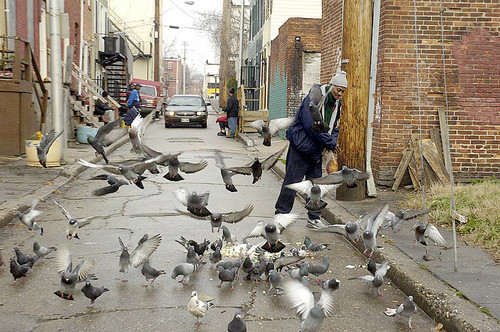
"New York is over-documented. Photographers are elbow to elbow," she says. But her Baltimore "is an undocumented place." On a muggy Monday morning, Cooper prowls the periphery of her self-designated turf, defined by Martin Luther King Boulevard to the east, Monroe Street to the west, Baltimore Street to the north and railroad tracks to the south. She speed-walks, toting a knapsack, an unwieldy camera bag and her Nikon. Petite, sandy-haired and solidly built, Cooper is attired practically for a morning stalking the streets. The urban explorer telegraphs the same air of belonging as the corner drug dealers. In a back alley off Carlton Street, a horse peers from the shadows of a barn. Cooper chats with regulars at one of the city's few remaining a-rab stables. A pause at Sowebo Gallery, then on to Ladies & Gents, a dry-cleaning shop on South Carrollton owned by Willette and Jerry Rosenbaum. The pair returned four years ago to Baltimore from Arnold. Cooper's camera became a passport to the spectacle of human experience that she has explored fearlessly ever since. "I see the world through my camera," she says. Without it, "I feel sort of naked." Cooper's need to carry a camera has made her a compulsive chronicler who is guided equally by design and instinct. The result is a body of work "intentionally and unintentionally created as something for the ages," Eff says.
Thailand RPCV Marty Cooper is pioneering Photographer in Baltimore
Street shooter
Pioneering photographer Marty Cooper turns her camera on a struggling Baltimore neighborhood
By Stephanie Shapiro
Sun Reporter
Originally published July 8, 2007
When Martha Cooper first spied the green and white of the empty sidewalk chairs, matching the trim on the Fulton Avenue rowhouse, the photographer had one reaction: She vowed to come back and meet the person responsible.
On a block in Southwest Baltimore lined with empty homes, she knew, a splash of paint is a promising sign of street life. Marty Cooper's presence itself speaks to the street's stealthy vitality. A New York-based photographer, Cooper, 64, became a hip-hop pioneer by documenting graffiti and break dancers. Now, the traveler who has passed through dozens of countries and communities has returned to her hometown to chronicle "a neighborhood over time."
"I came here because I want to become part of the community," she says. The move represents a reversal for the restless soul; until recently, Baltimore "didn't enter my consciousness as a place I'd want to photograph."
An exhibit of her Sowebo work to date opens Thursday at the Maryland State Arts Council in South Baltimore. Even as these photographs grasp the power of local custom, they expose the raw edge of dissolution.
"I don't try to be an artist. It shows in my pictures," Cooper says. There are no artsy angles or artificial lighting techniques. "Having a show is not my aim. I'm shooting with history in mind."
Riveting tensions - between tenderness and belligerence, tradition and upheaval - inform Cooper's show. Images of a crab feast, a marching band and a pigeon fancier draw up short against a shot of boys poring over a catalog of semi-automatic weapons. Snowball stands, an a-rab wagon brimming with produce, schoolchildren in care of an elder speak of community. Blasted streetscapes suggest otherwise.
"She sees everything," says Elaine Eff, director of the cultural conservation program at the Maryland Historical Trust and co-founder of Maryland Traditions, one of the groups supporting Cooper's project. "She turns every passing activity into a snapshot, a document that tells you more than you would ever have imagined."
'Camera runs'
Marty Cooper received her first camera, a Baby Brownie, at age 5. From then on, her father, co-owner of Cooper's Camera Mart in Hamilton, supplied the fledgling photographer with state-of-the-art equipment. She often joined her father, who died in 1991, on organized "camera runs" that took shutterbugs to the Inner Harbor, fox hunts and other visual feasts.
Cooper's camera became a passport to the spectacle of human experience that she has explored fearlessly ever since.
"I see the world through my camera," she says. Without it, "I feel sort of naked."
Cooper's need to carry a camera has made her a compulsive chronicler who is guided equally by design and instinct.
The result is a body of work "intentionally and unintentionally created as something for the ages," Eff says.
On a muggy Monday morning, Cooper prowls the periphery of her self-designated turf, defined by Martin Luther King Boulevard to the east, Monroe Street to the west, Baltimore Street to the north and railroad tracks to the south.
She speed-walks, toting a knapsack, an unwieldy camera bag and her Nikon. Petite, sandy-haired and solidly built, Cooper is attired practically for a morning stalking the streets. The urban explorer telegraphs the same air of belonging as the corner drug dealers.
In a back alley off Carlton Street, a horse peers from the shadows of a barn. Cooper chats with regulars at one of the city's few remaining a-rab stables.
A pause at Sowebo Gallery, then on to Ladies & Gents, a dry-cleaning shop on South Carrollton owned by Willette and Jerry Rosenbaum. The pair returned four years ago to Baltimore from Arnold.
"She can see the beauty where someone else can't," Willette Rosenbaum says of Cooper's photos, some of which hang in the storefront.
Cooper launched her work in Sowebo with $3,300 of state funds granted through the nonprofit housing organization Southwest Visions. The photo project, with or without more funding, could continue for the rest of her working life, she says.
The same nervous energy that Cooper displays on her rounds has propelled her through life thus far. She earned an art degree at age 19 from Grinnell College, taught English in Thailand for the Peace Corps, journeyed by motorcycle from Bangkok to London (a Sun headline called her "The First of Her Sex to Cross Asia and Europe by Motor Bike") and received an ethnology diploma from Oxford. She lived for a period in Japan, married, divorced and, in 1977, joined the staff of the New York Post.
"Chasing, chasing, chasing" the rival Daily News to accidents and crime scenes, and enduring her editors' wrath when she missed a scoop, made the job wearying.
Still, the Post led the photographer to her calling.
As she meandered on the job through some of New York's poorest neighborhoods, Cooper captured children at play in abandoned buildings and empty lots. Using cast-off tires, tin cans and other detritus, the intrepid kids created playthings for their own imaginary worlds. (The black-and-white images would eventually become the book Street Play, published in 2005.)
"I don't want to ask too many questions," Cooper says of the brief, casual conversations that have granted her entree to her subjects. But, "If I hang around, I'll hear a lot."
It was after Cooper earned the trust of an aspiring graffiti artist in New York that he introduced her to "Dondi," the young man considered the king of the outlaw art form. Through Dondi, who died in 1998, Cooper gained access to an underground world of artists who risked their lives "getting up" fleeting masterpieces on the sides of subway cars.
Pursuing a passion
"The ephemeral art of everyday life," as Cooper describes it, became her passion from then on.
Subway Art, her 1984 collaboration with photographer Henry Chalfant, gave graffiti mainstream credibility and inspired artists around the globe.
If Cooper was dazzled by graffiti's illicit energy, she became convinced of its artistry while watching Dondi and his friends prepare for all-night painting sessions. A process she once thought random was actually deliberate.
"Suddenly, it was like a foreign language becoming clear to me. Then I was completely hooked," Cooper says in Hip Hop Files, a retrospective of her work published in 2004. Her insistence on capturing the procedure from start to finish paid off.
"The finest photographs to come out of the early days of hip-hop were taken by a pixieish woman with a mischievous, infectious grin," a graffiti artist named Zephyr writes in the same book. Cooper "relied on her own tenacity, ambition, creativity, and bold determination to go wherever she had to go and do what she had to do to get the shot."
Recently, Cooper decided to take a break from hip-hop. Last year, she bought a home close to Hollins Market from the artist John Ellsberry. While her fellow New Yorkers flock to the Hamptons on weekends, Cooper retreats to Sowebo, where she has become the unofficial "community photographer."
The new home also allows Cooper more frequent visits with first cousin and best friend Sally Levin, a retired schoolteacher who lives in Columbia.
In the 1960 history The Szolds of Lombard Street: A Baltimore Family, 1859-1909, Cooper's aunt, Alexandra L. Levin, wrote about the relatives who had settled in Southwest Baltimore. (They included Cooper's great-aunt, Henrietta Szold, founder of the Jewish philanthropic organization Hadassah.)
But Cooper, born on Eutaw Place and raised in Mount Washington, rarely set foot in Southwest Baltimore. As she began exploring her new neighborhood, though, Cooper found fertile ground.
"New York is over-documented. Photographers are elbow to elbow," she says. But her Baltimore "is an undocumented place."
On her rounds, Cooper visits Dave Wise, a larger-than-life welder who works out of an old gas station. He demands a big hug. She passes him a color print of the sun-shaped window grill he made for her.
Giving photos to her sources is a way of earning trust, Cooper says.
She also shoots a teddy-bear-and-balloon shrine for Kianna Sharde Johnson, struck and killed by a car the week before.
Cooper labors matter-of-factly, noting tributes added since she last saw the memorial, but saying little. She allows the tragedies recognized in her work to speak for themselves. Her bustling manner belies emotions, kept in check by the necessity to work at all costs.
"She walks through those streets with the most tremendous sense of love, appreciation and confidence that what she sees is really showing life at its best," Eff says.
This chronicler of sorrow and grief maintains a whimsical side, too. Cooper collects photo-themed toys, figurines and photos of female photographers, and images of the "Kodak Girl," the ingenue depicted in turn-of-the-20th-century advertising.
Advertisement
"The minute I first saw one of those early ads at an antique show, I identified with this woman," Cooper writes on her Web site, kodakgirl.com. "I WAS the Kodak Girl."
Kodak Girl darts from one location to another, just as she moves from one project to another. Later in the week, she'll attend a hip-hop convention in Minneapolis for "b-girlz," female hip-hop dancers and performers. We B*Girlz, a visual and oral history of the female hip-hop movement by Cooper and Nika Kramer, was published in 2005.
As director of photography for City Lore, a Manhattan-based heritage-preservation organization, and as a go-to photographer for academic researchers, Cooper has documented New York City's rich cultural mosaic beyond the hip-hop world.
"By looking at the everyday aspects of life and taking detailed, insightful pictures, Marty has been able to create an incredible historical record on a day-to-day basis," says Steve Zeitlin, City Lore's executive director.
On her morning walk, Cooper captures a slumbering man on a sidewalk couch and his vigilant hound. A rehabbed house in an abandoned block piques her curiosity as well.
"I find the whole block interesting," she says. "It's not good for pictures, not good for exhibitions, but for history. Who knows what it will look like in 10 years?"
Cooper stops as well for R.I.P. graffiti, complete with skull and crossbones, which she shoots for her "R.I.P. file." In 1994, she produced R.I.P.: Memorial Wall Art with Joseph Sciorra. The book documented public portraits around New York honoring youth who have died violently. After Sept. 11, the Municipal Arts Society in Manhattan mounted the exhibit "Missing," featuring Cooper's photos of the shrines created for victims of the World Trade Center attack.
As she shoots, Cooper engages her sources outside, not venturing into their homes.
"I'm a street photographer," she says. "As soon as you get inside, you lose the sense of neighborhood."
She records a post-eviction pile of belongings picked through by a passer-by. "Heartbreaking," she says. And she chats with a contractor betting that a biopark under construction nearby will draw hundreds of new residents.
Around the corner from her home, Cooper passes a startling oasis: a shaded pond filled with water lilies, a totem pole and a stone fountain topped with a cross.
Nearby, a weeping woman sits on the steps, nursing her head just after a mugging. Shortly, she leaves in a police car.
Cooper is dismayed but not fearful. She has worked in the South Bronx and other urban wastelands, and won't allow fear to distract her.
Besides, she has found the source of that promising sign of street life on South Fulton Avenue. Joan Kuniken, joined by one of her six daughters, a son-in-law and a boarder, reigns from one of the painted chairs. She is happy to share her design tips, not to mention her life story, with Cooper.
Kuniken has just buried one of her 12 children; her sugar, glaucoma and blood pressure have been acting up; she still hasn't found a decent man at any senior club; and her community is in decline.
"When we moved here, this was a beautiful block," says Kuniken, 72. "The neighborhood gradually deteriorated."
And, yet, Kuniken smiles at the thought of the fresh coat of paint - lavender and gold - her furniture is to receive in time for the Fourth of July.
Cooper promises to return with photos and to shoot the freshly painted chairs.
It is one small transaction in a community teetering between destitution and rebirth. For Cooper, it's the perfect balance.
"I picked a good neighborhood," she says. "Don't you think?"
stephanie.shapiro@baltsun.com
